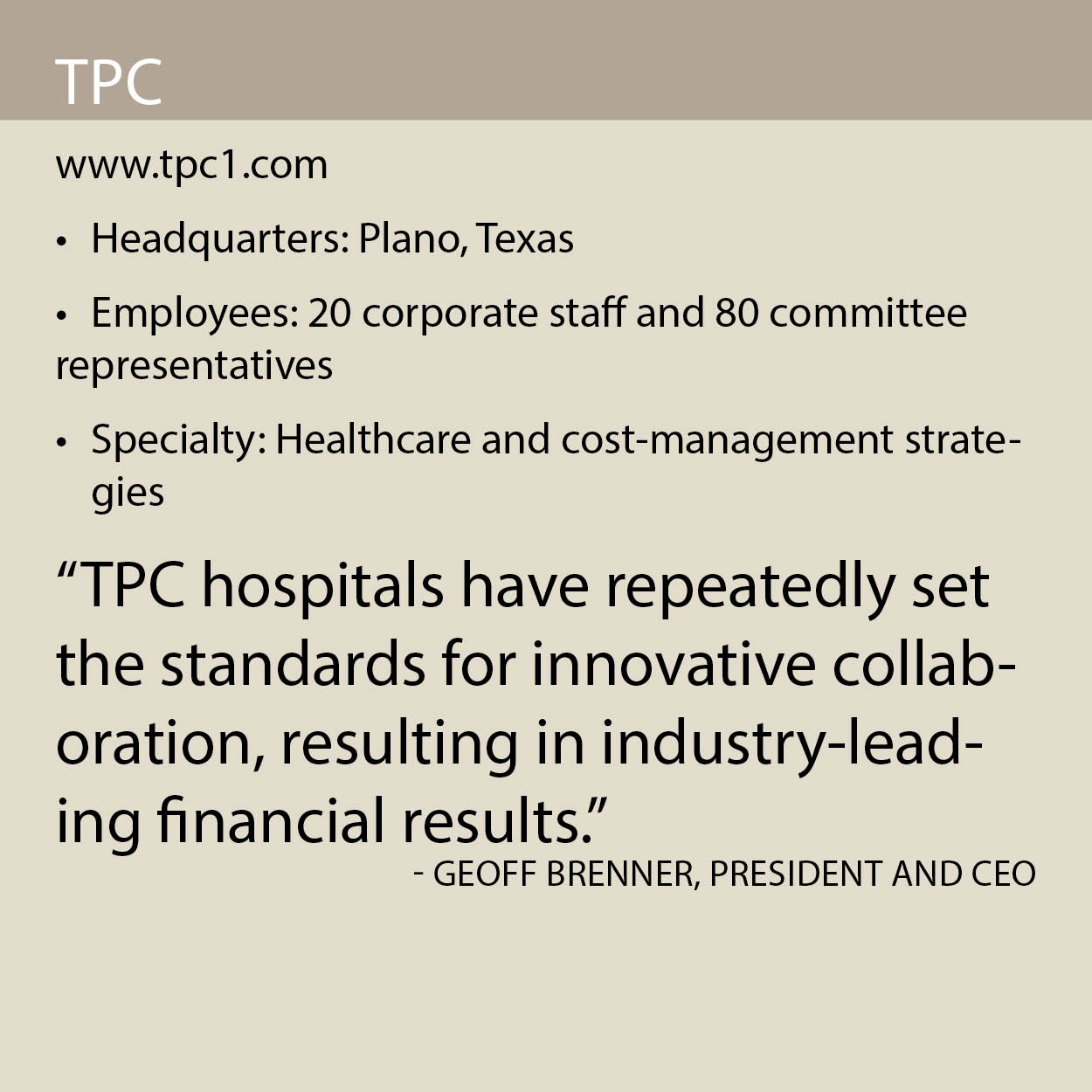TPC
TPC helps hospitals achieve significant economies of scale by collaborating as a single, highly committed contracting entity.
By Alan Dorich
It has been said that culture trumps strategy, and it is TPC’s culture of innovation and commitment that enables its hospital members to endure the highs and lows of the increasingly volatile healthcare market, President and CEO Geoff Brenner says. “Culturally, we have developed into a very fluid and adaptable organization that consistently achieves market-leading results amid unprecedented industry disruption,” he says.
Based in Plano, Texas, TPC is a hospital-owned coalition that focuses on innovative cost-reduction strategies within supply chain, purchased services and clinical product utilization. Its history goes back to 2007 when several large health systems conducted a study to measure the true value of consolidation.
“The results of the study revealed that as much as 80 percent of the anticipated financial value generated by hospital consolidation could potentially be achieved by collaborating as a single, committed contracting entity and if successful, it would diminish the need to merge assets,” Brenner explains, noting that the group ultimately chose not to merge assets but rather to form a highly-committed partnership by creating TPC.

Today, TPC consists of 11 healthcare systems located in three states and has achieved more than $180 million in documented savings since 2010. “By working together as a single contracting entity, TPC hospitals have developed the collective market footprint of a very large integrated delivery network, with a very high commitment level,” Brenner says. “They collaborate as one system to achieve the economies of scale they need to remain financially strong to serve their local markets.”
Two specific areas where TPC has achieved industry-leading financial results are within difficult clinical product categories and purchased services. “On average, TPC members have documented a 20 percent reduction in their supply costs,” Brenner says.
Tough Enough
Brenner has been in the healthcare industry since 1995 and originally served as the president of TPC’s parent company. He credits TPC’s success to the hospitals’ unwavering commitment to each other and the sophisticated self-governance model that has evolved over the years.
“They collaborate as one system,” he says, noting that this enables the company to strategically focus on savings opportunities that are the most difficult to achieve, but offer the highest financial return.
“Often times healthcare supply coalitions set lofty goals to pursue the tougher, higher-yield product or service categories, but those ambitions often fail to materialize because the governance structure was not engineered to deal with inter-hospital conflict, difficult tradeoffs and the binding commitment that is required,” he says. “TPC’s board, executive steering committee, supply chain leaders and physician/clinical leaders have consistently demonstrated the courage to tackle the most challenging scenarios because they recognize their collective ability to optimize their supply chain has a direct correlation to their financial health, and their ability to provide safe, cost-effective care to their local communities.’”
The Best Model
TPC hospitals routinely evaluate the value propositions offered by their suppliers, Brenner says. “Within the hospital sector, the focus on costs and value are unrelenting,” he states. “Every decision maker is under immense pressure to make prudent, sustainable choices.”
Oftentimes this effort requires physicians to evaluate supplies and vendors they have used for many years. This prospect can be very difficult, since the physicians may have developed strong preferences for the products they use on a regular basis and strong alliances with the supplier representatives. “Navigating those scenarios is one of the greatest challenges,” he admits.
But TPC addresses this challenge by providing the physicians with clinical and financial data that reveals, often for the first time, clinical utilization patterns, clinical outcomes (quality), product costs and ultimately, value. Physicians are highly educated, intelligent, ethical and data-driven; when presented with concise, well-vetted data, they prudently evaluate the variables and propose one or more viable alternatives. That is the power of strong member-led governance.
“Alternatively, if TPC approached the physicians with a preformed agenda that required them to convert from Supplier A to Supplier B, they would justifiably resist the change,” Brenner says. “But as they collaborate as peers and their confidence in the data and the process builds, they identify options to improve the cost metrics without sacrificing clinical quality or patient care.”
Committed to Change
Brenner is proud of the culture at TPC. “There’s a relentless commitment to innovate and evolve,” he says, noting that it requires employees to become increasingly more “comfortable with unprecedented ambiguity.”
Although the work itself can be very challenging, “We have learned to confront each obstacle as a team, and in that approach we have developed a love for what we do, with whom we do it, and for the healthcare organizations for which we do it,” he says. “The real credit belongs to the TPC hospitals; they have been setting the bar day in and day out since 2007.”
TPC’s plan is to stay aggressive when it comes to serving its hospital members and innovating cost reduction strategies within supply chain, purchased services, and even revenue cycle (a new strategic focus area). “Together, we’ve created significant momentum, economies of scale and tangible value.” he says.
“As we move forward, TPC may be required to expand beyond contracting and explore process-related opportunities,” he predicts. “The worst thing we can do is look at the results we’ve had and think that trajectory continues upward without continually, and often radically, rethinking our business.”